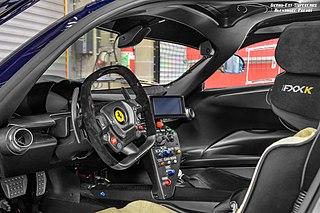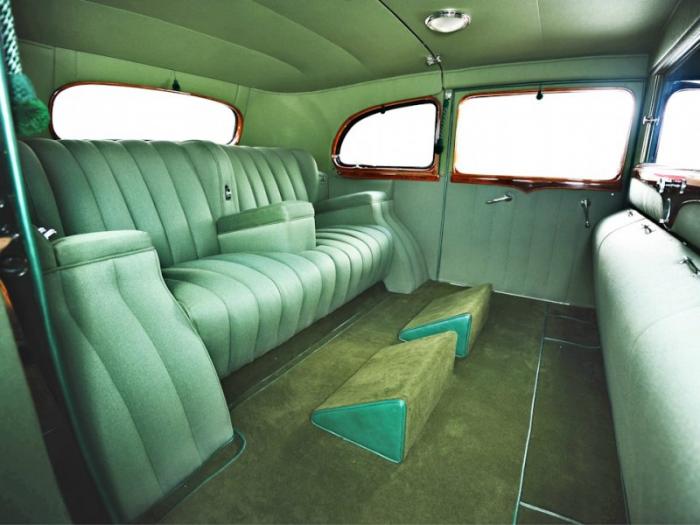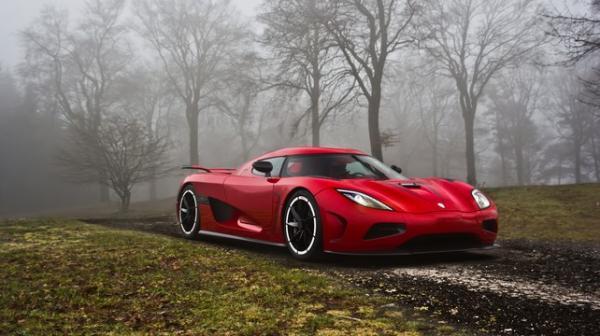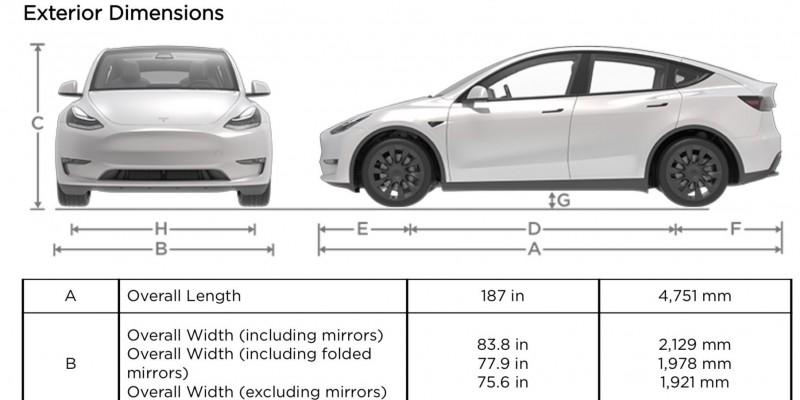Cord automobile
Содержание:
Revival
The 810/812 design was re-marketed almost immediately, in 1940, as ailing automakers Hupmobile and Graham-Paige tried to save money, and revive the companies, by using the same body dies. Except for their similarity to the 810, their 4-door sedans, the Hupp Skylark and the Graham Hollywood, were unremarkable. Retractable headlights gave way to plain headlight pods, and power came from a standard front-engine/rear-wheel drive design. Only about 1900 were built before production ceased in the fall of 1940.[citation needed]
Between 1964 and 1970, two further attempts were made to replicate the original Buehrig design for limited production. Both Tulsa, Oklahoma-based companies soon halted production amid financial difficulties. The 1966 replica Cord 8/10 was powered by a Corvair drivetrain (the «8/10» designation represented the actual scale of the car), while the 1968 through 1970 models were Ford and Chrysler powered.[citation needed]
The design of the Cord 810/812 remains one of the most distinctive of the 20th Century. In 1996, American Heritage magazine proclaimed the Cord 810 sedan ‘The Single Most Beautiful American Car’. The ‘Classic Cord’ Hot Wheels toy car of the 1960s, a convertible coupé, is one of the most valuable, and commands up to US$800 (2006) if still in an unopened package.
Cord 810
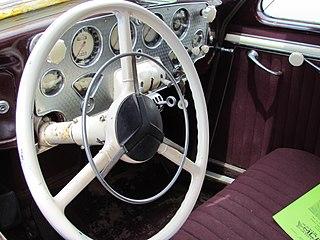
Приборная панель
Модель 810 была призвана спасти от банкротства автомобильную компанию и появилась через три года после сворачивания производства Cord L-29. Впервые её увидели посетители Нью-Йоркского автошоу 2 ноября 1935 года. Готовили модель неполных четыре месяца, для участия в шоу нужно было создать сто экземпляров, поэтому выставочные образцы даже не имели трансмиссии — разработчики просто не успели их собрать окончательно. Однако благодаря необычной внешности и техническим инновациям заказов поступало много. У новинки был похожий на крышку гроба капот, регулируемые стеклоочистители, убирающиеся в крылья фары, а сами крылья имели форму поплавков, устанавливаемых на гидропланах. У автомобиля был несущий кузов, дорожный просвет составлял 270 мм (из-за чего пришлось отказаться от подножек), двери внутренними петлями крепились к средней стойке, а крыша варилась из семи отдельных элементов. Примечательно, что у машины не было традиционной решётки радиатора. Вместо неё вокруг капота шли стальные рёбра, прозванные «луврами».
Специально для Cord 810 фирмой Lycoming был спроектирован двигатель V8 объёмом 4729 см³, в котором широко использовался алюминий. Мотор мощностью 125 л. с. разгонял авто до 152 км/ч. Впоследствии появилась компрессорная версия, которая отличалась выведенными наружу трубами в гофрированных рукавах из нержавеющей стали. В то время это был первый американский переднеприводный автомобиль с независимой передней подвеской. Полуавтоматическая четырёхступенчатая коробка передач была выдвинута перед двигателем, это позволило дизайнеру Гордону Бьюригу отказаться от карданного вала и туннеля трансмиссии.
Несмотря на все эти новшества, рыночного успеха модель не завоевала. Поставки дилерам начались с опозданием, планировалось производить до тысячи автомобилей в месяц, но производство тормозилось из-за трансмиссии. В Нью-Йорк первые автомобили попали лишь в апреле 1936 года. Впоследствии у него обнаружился ряд проблем: не всегда включались передачи, мотор перегревался, отказывали другие узлы. Хоть со временем многие неисправности были устранены, у марки сложился резко отрицательный имидж. В целом, Cord удалось продать только 1174 новых 810 в первый год выпуска из-за проблем с механикой.
Cord L-29
This was the first American front-wheel drive car to be offered to the public, beating the Ruxton automobile by several months, in 1929. The brainchild of former Miller engineer Cornelius Van Ranst, its drive system borrowed from the Indianapolis 500-dominating racers, using the same de Dion layout and inboard brakes. Built in Auburn, Indiana, the Cord was the first front-wheel-drive car to use constant-velocity joints. While commonly used today in all front-wheel-drive vehicles, their first use was on the 1929 Cord. The lack of rear drivetrain components and straight frame (without rear kick-up to clear up the rear axle) allowed it to be much lower in height than competing cars whose average height was about six feet or almost two metres. Both stock cars and special bodies built on the Cord chassis by American and European coachbuilders won prizes in contests worldwide. The L-29 came with full instrumentation, including a temperature gauge, oil pressure gauge, and speedometer on the left with a gas gauge, oil level gauge, and Ammeter on the right of the steering wheel.
It was powered by Auburn’s 4,934 cc (301 cu in) 125 hp (93 kW) L-head 120, with the crankshaft pushed out through the front of the block and the flywheel mounted there, driving a three-speed transmission. Gearing in both transmission and front axle was inadequate, and the 4,700 lb (2,100 kg) car was underpowered, limited to a trifle over 80 mph (130 km/h), inadequate even at the time, and readily exceeded by the less expensive Auburn. Still, the styling was lovely, and despite the 137.5 in (3,490 mm) wheelbase and steering demanding fully four turns lock-to-lock, handling was reportedly superb. Priced around US$3,000, it was competitive with Cadillac, Marmon, Lincoln, Packard, Franklin, and Stutz; the 1930 Chrysler copied several styling elements. It could not outrun the Great Depression, and by 1932, it was discontinued, with just 4,400 sold. Wheelbase was 137.5″ and the height of the sedan was 61″.
References
- ^ Burgess-Wise, David (1974), Northey, Tom (ed.), «Cord: The Apex of a Triangle», World of Automobiles, London: Orbis, 4, p. 436
- ^ , p. 437.
- Newbury, Stephan (2006). The car design yearbook 4. Merrell. ISBN 1-85894-286-1.
- Kimes and Clark. Standard Catalog of American Cars, 1805-1942, p.364.
- Kimes and Clark, p.364.
- Flory, J. «Kelly», Jr. American Cars 1946-1959 (Jefferson, NC: McFarland & Coy, 2008), p.979.
- , pp. 436-437.
- Cheetham, Craig (2004). Vintage Cars — The Finest Prewar Automobiles. Rochester, United Kingdom: Grange Books. p. 67. ISBN .
- Kimes, Beverly (1996). standard catalog of American Cars 1805-1942. Krause publications. ISBN 0-87341-428-4.
- ^ Craig Cheetham (ed.). Ultimate American Cars. Amber Books Ltd. ISBN 0-7603-2570-7.
English[edit]
English Wikipedia has articles on:cord
Wikipedia
An electrical cord.
Cord consisting of twisted fiber.
Etymologyedit
From Middle English , from Old French , from Latin , from Doric Ancient Greek χορδά (khordá, “string of gut, the string of a lyre”) (compare Ionic (khordḗ), from Proto-Indo-European *ǵʰer- (“bowel”)). More at yarn and hernia.
Pronunciationedit
- (General American) IPA(key): /kɔɹd/
- (Received Pronunciation) IPA(key): /kɔːd/
-
Audio (US) (file) - Rhymes: -ɔː(ɹ)d
- : , (in accents with the horse-hoarse merger), (in non-rhotic accents)
Nounedit
cord ( and , plural )
- A long, thin, flexible length of twisted yarns (strands) of fiber (rope, for example); (uncountable) such a length of twisted strands considered as a commodity.
- The burglar tied up the victim with a cord.
- He looped some cord around his fingers.
- A small flexible electrical conductor composed of wires insulated separately or in bundles and assembled together usually with an outer cover; the electrical cord of a lamp, sweeper ((US) vacuum cleaner), or other appliance.
- A unit of measurement for firewood
1851, Herman Melville, Moby-Dick:Unerringly impelling this dead, impregnable, uninjurable wall, and this most buoyant thing within; there swims behind it all a mass of tremendous life, only to be adequately estimated as piled wood is—by the cord
, equal to 128 cubic feet (4 × 4 × 8 feet), composed of logs and/or split logs four feet long and none over eight inches diameter. It is usually seen as a stack four feet high by eight feet long.
-
() Any influence by which persons are caught, held, or drawn, as if by a cord.
-
1884, Alfred Tennyson, To —
- The knots that tangle human creeds, / The wounding cords that bind and strain / The heart until it bleeds.
-
1900, Charles W. Chesnutt, The House Behind the Cedars, Chapter I,
- Every detail of the house and garden was familiar; a thousand cords of memory and affection drew him thither; but a stronger counter-motive prevailed.
-
1884, Alfred Tennyson, To —
-
(anatomy) Any structure having the appearance of a cord, especially a tendon or nerve.
- spermatic cord; spinal cord; umbilical cord; vocal cords
- : musical sense.
- : a cross-section measurement of an aircraft wing.
Synonymsedit
- (length of twisted strands) ,
- (wires surrounded by an insulating coating, used to supply electricity) ,
- See also Thesaurus:string
Translationsedit
length of twisted strands
|
|
wires surrounded by a coating, used to supply electricity
|
|
unit of measurement for firewood
|
|
- To furnish with cords
- To tie or fasten with cords
- To flatten a book during binding
- To arrange (wood, etc.) in a pile for measurement by the cord.
Revival
Hupmobile Skylark
The Cord 812 design was re-marketed almost immediately in 1940, as ailing automakers Hupmobile and Graham-Paige tried to save money, and revive the companies, by using the same body dies. Except for their similarity to the 810, their four-door sedans, the and the , were unremarkable. Retractable headlights gave way to plain headlight pods, and power came from a standard front-engine/rear-wheel drive design. While Hupp Motor Company built a few prototypes in 1939 that gained them sales orders for the 1939 model year they did not have the resources to manufacture the car. Graham Paige stepped in offering to build the Hupmobile Skylarks on a per piece contract basis. Graham built a combined 1850 units for sale in the 1940 model year. Hupmobile closed before the 1941 model came around. Of the 1850 cars produced in the 1940 model year by Graham only about 450 were the Hupmobile Skylarks. Graham continued to build the Hollywood late into 1941. They stopped production in November of that year having only built a rumored 400 units. The Hollywood was powered by a supercharged Continental in line six making 124 HP, almost 50 less than the original supercharged Cord.
Cord Model 810/812
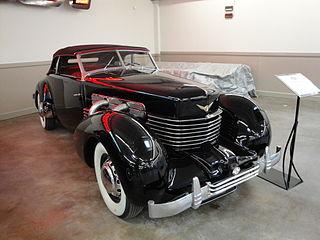
1937 Cord 812 Phaeton
The Model 810/812 are probably the best-known of the company’s products. Styled by Gordon M. Buehrig, they featured front-wheel drive and independent front suspension; the front drive enabled the 810 to be so low, running boards were unnecessary. Powered by a 4,739 cc (289 cu in) Lycoming V8 of the same 125 horsepower (93 kilowatts) as the L-29, the 810 had a four-speed electrically-selected semi-automatic transmission, among other innovative features.
The car caused a sensation at the New York Auto Show in November 1935. Orders were taken at the show with Cord promising Christmas delivery, expecting production of 1,000 per month. Production delays pushed the expected delivery date to February 1936. This proved optimistic; the first production vehicles were not delivered until April. In all, Cord managed to sell only 1,174 of the new 810 in its first model year. The car is well known for the flat front nose with a louvered grille design. The front was so similar in look to a coffin, the car was often called «Coffin Nose».
Инновации
L-29 1930 года
В числе инновационных автомобилей Cord были переднеприводный L-29 и аэродинамичные модели 810 и 812 с убираемыми в крылья (потайными) передними фарами.
Переднеприводные автомобили получили широкое распространение в Соединённых Штатах Америки только с конца 1970-х, хотя отдельные переднеприводные машины выпускались и ранее, например, с 1962 года западногерманский филиал Ford Köln выпускал малолитражки Ford 12M P4, а с 1966-го — рестайлинговый Ford 12M P6 на переднеприводной платформе, которую в конце 1950-х разработала именно головная североамериканская компания Ford Motor как проект Ford Cardinal — конкурент для VW 1200 («Жук») на американском рынке. Проект, однако, был отменен маркетологами Ford, как слишком непривычный для американских потребителей и заменен на проект классического Ford Falcon. Так, что реально первыми послевоенными американскими переднеприводными автомобилями стали премиальные «персональные купе» Oldsmobile Toronado 1966 года и Cadillac Eldorado 1967 года на т. н. Е-платформе производства General Motors.
Складывающиеся в крылья фары не были стандартным оборудованием в США (и во всем мире) до 1960-х годов, хотя ими и оснащались автомобили DeSoto 1942 года. Ранний дизайн модели Oldsmobile Toronado с потайными фарами, по словами дизайнеров GM, разрабатывался именно под влиянием модели Cord 810/812. Собственно, переднеприводное купе Toronado и было своего рода идейной реинкарнацией довоенного Cord.
History
The styling of the Cord 810 was the work of designer Gordon M. Buehrig and his team of stylists, which included young Vince Gardner and Alex Tremulis. While the first American front-wheel-drive car with independent front suspension, it had an archaic tube rear axle with semi-elliptic rear springs. Power came from a 4,739 cc (289 cu in)Lycoming V8 of the same 125 hp (93 kW) as the L-29. The semi-automatic four-speed transmission (three plus overdrive)extended in front of the engine, like on a Traction Avant. This allowed Buehrig to dispense with the driveshaft and transmission tunnel; as a result, the new car was so low it required no running boards. It had a 125 in (3,175 mm) wheelbase (shared with several 812 body styles), and in 1936 came in four models: the entry-level sedan at US$1995, the Beverly sedan ($2095), Sportsman ($2145), and Phaeton ($2195). The 1937 812s had the same models, priced $2445, $2545, $2585, and $2645, plus two more, on a 132 in (3,400 mm) wheelbase, the $2960 Custom Beverly and $3060 Custom Berline.\’
Reportedly, conceived as a Duesenberg and nearly devoid of chrome, the 810 had hidden door hinges and rear-hinged hood, rather than the side-opening type more usual at the time, both new items. It featured pontoon fenders with hidden headlamps (modified Stinson landing lights) (E. L. Cord owned a majority of Stinson stock) that disappeared into the fenders via dashboard hand cranks. This car was first and one of the few ever to include this feature.
It also featured a concealed fuel filler door and variable-speed windshield wipers (at a time when wipers were often operated by intake vacuum, and so tended to stop when the driver stepped on the gas pedal). Its engine-turned dashboard included complete instrumentation, a tachometer, and standard radio (which did not become an industry standard offering until well into the 1950s). The most famous feature was the «coffin nose», a louvered wraparound grille, from which its nickname derived, a product of Buehrig’s desire not to have a conventional grille.
Supercharged 1937 Cord 812 Sedan
The car caused a sensation at its debut at the New York Auto Show in November 1935. The crowds were so dense, attendees stood on the bumpers of nearby cars to get a look. Cord had rushed to build the 100 cars needed to qualify for the show, and the transmission was not ready. Even so, Cord took many orders at the show, promising Christmas delivery, expecting production of 1,000 per month, but the semi-automatic transmission was more troublesome than expected, and 25 December came and went with no cars built. The first production cars were not ready to deliver until February, and did not reach New York City until April 1936. In all, Cord managed to sell only 1,174 of the new 810 in its first model year, as the result of mechanical troubles.
Supercharging was made available on the 1937 812 model, with a mechanically driven Schwitzer-Cummins unit. Supercharged 812 models were distinguished from the normally aspirated 812s by the brilliant chrome-plated external exhaust pipes mounted on each side of the hood and grill. With supercharging, horsepower was raised to 170.
Early reliability problems, including slipping out of gear and vapor lock, cooled initial enthusiasm. Although most new owners loved their sleek fast cars, the dealer base shrank rapidly. Unsold left-over and in-process 1936 810 models were re-numbered and sold as 1937 812 models. In 1937, after producing about 3000 of these cars, Auburn ceased production of the Cord. A single 1938 Cord prototype, with detail changes to the grille and transmission cover, was built, and it survived as of 2009.[citation needed]
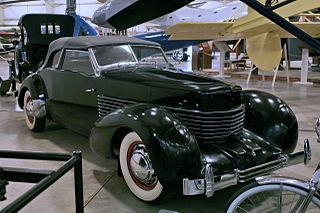
1936 Cord 810 Phaeton
Ironically, the next two American cars to use a front-wheel drive layout, the 1966 Oldsmobile Toronado and 1967 Cadillac Eldorado (both built on GM’s E-Body platform), also had hidden headlamps.
In popular culture
The plot of the David Niven movie Where the Spies Are features a rare Cord convertible as the incentive for the hero to undertake an espionage mission.
The movie Where the Spies Are was based on the James Leasor novel Passport to Oblivion, which is one of a series of suspense/intrigue novels featuring the fictitious Dr. Jason Love, whose «infatuation» with the Cord roadster played a prominent part.
In the novel Live and Let Die, Felix Leiter drives a Cord of unspecified model when he and James Bond are in Florida.
The original design for the Batmobile was a red convertible based on the Cord 812, which Batman creator Bob Kane considered one of his favorite vehicles and fitting for the millionaire vigilante.
The 1965 film What’s New Pussycat? featured a rather battered red Cord 810 convertible with French selective yellow headlights. The car was piloted in several scenes by Woody Allen whose character drove on the Paris pavements (sidewalks).
In the 1994 film The Shadow, Moses Shrevnitz (Peter Boyle) drives a 1936 Cord 810 Westchester that was stretched and custom-painted as a taxi cab.
«bePUZZLED» brand puzzles is a series of puzzles which feature a short mystery story to go along with the picture in the assembled puzzle. A puzzle and story in the series is called A Classic Case of Murder and features a creme colored 1936 810 Cord in the story and pictured in the puzzle. Copyright 1992.
In the 2001 PlayStation exclusive car combat game Twisted Metal: Black. The playable driver No-Face has a car based on the Cord 810,
nicknamed «Crazy 8».
On Gram Parsons’ 1973 album GP, the song «The New Soft Shoe» is written about E.L Cord and his famous automobiles.
In classic crime film The Godfather, a Cord 810 convertible is briefly seen on the estate of Jack Woltz.
Some sung versions of Rodgers and Hart song «Lady is A Tramp» refer to «Lincolns and Cords»
Cord L-29
Cord L-29 являлся первым американским переднеприводным автомобилем в 1929 году, опередив Ruxton на несколько месяцев. Являясь детищем бывшего инженера Карла Ван Ранста (Carl Van Ranst), он заимствовал привод гоночных машин Indianapolis 500 с компоновкой и тормозами de Dion, что позволило его силуэту быть ниже конкурирующих машин. Автомобили, построенные на шасси Cord с кузовами от ведущих американских и европейских производителей, участвовали в конкурсах по всему миру. Образец, получивший корпус дизайна Алексея Сахновского, выиграл награды трёх конкурсов: в Монте-Карло, Париже и Бьюли.
Автомобиль оснащался рядным 8-цилиндровым двигателем Auburn объёмом 4934 см³ (301 дюйм³) мощностью 125 л. с. (93 кВт) и 3-ступенчатой механической коробкой передач. Число передач было недостаточным и машина весом 4700 фунтов (2100 кг) могла развивать максимальную скорость только 80 миль/час (130 км/ч), что было недостаточно; менее дорогие Auburn развивали бо́льшую скорость. Тем не менее, автомобиль с колёсной базой 137,5 дюйма (3490 мм) и стоимость около $3000 пользовался популярностью у состоятельных людей и успешно конкурировал с такими марками, как Marmon, Lincoln, Packard, Franklin и Stutz. В 1930 году Chrysler скопировал некоторые элементы стиля.
Начавшаяся «Великая депрессия» положила конец производству автомобиля в 1932 году; всего выпущено около 4400 машин.
Cord 812
Приборная панель
| Cord 812 | ||||||||||||||||
|---|---|---|---|---|---|---|---|---|---|---|---|---|---|---|---|---|
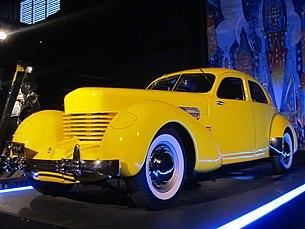 |
||||||||||||||||
| Общие данные | ||||||||||||||||
| Производитель | Cord Automobile | |||||||||||||||
| Годы производства | — | |||||||||||||||
| Дизайн | ||||||||||||||||
| Тип кузова | 4‑дв. седан (4‑мест.)4‑дв. кабриолет (4‑мест.) | |||||||||||||||
| Компоновка | переднемоторная, переднеприводная | |||||||||||||||
| Двигатель | ||||||||||||||||
|
||||||||||||||||
| Трансмиссия | ||||||||||||||||
| 4-ст. полуавтомат | ||||||||||||||||
| Массово-габаритные характеристики | ||||||||||||||||
| Длина | 4801 мм | |||||||||||||||
| Ширина | 1956 мм | |||||||||||||||
| Колёсная база | 3355 мм | |||||||||||||||
| На рынке | ||||||||||||||||
| Сегмент | F-сегмент | |||||||||||||||
| Другая информация | ||||||||||||||||
| Дизайнер | Гордон Бьюриг | |||||||||||||||
| ← Cord 810 | ||||||||||||||||
| Медиафайлы на Викискладе |
В 1936 году, чтобы спасти сложившееся положение, была представлена модель 812. Колёсная база достигла 3353 мм, жёсткость кузова возросла, увеличилась и высота машины. Автомобиль стал выпускаться в шести исполнениях — разных видах седана и кабриолета. Двигатель снабдили нагнетателем, в итоге мощность довели до 190 л. с., мотор разгонял автомобиль до 177 км/ч, делая его одной из самых быстрых моделей своего времени. Позже на данном суперкаре установили несколько десятков национальных рекордов для серийных авто, среди которых 29,35 км на одном галлоне топлива и 3055,76 км за 24 часа езды по кирпичному треку в Индианаполисе. Однако всё это не спасло производителя от банкротства: 7 августа 1937 года с конвейера сошёл последний Cord. Сегодня один экземпляр Cord 812 экспонируется в Нью-Йоркском музее современного искусства.
